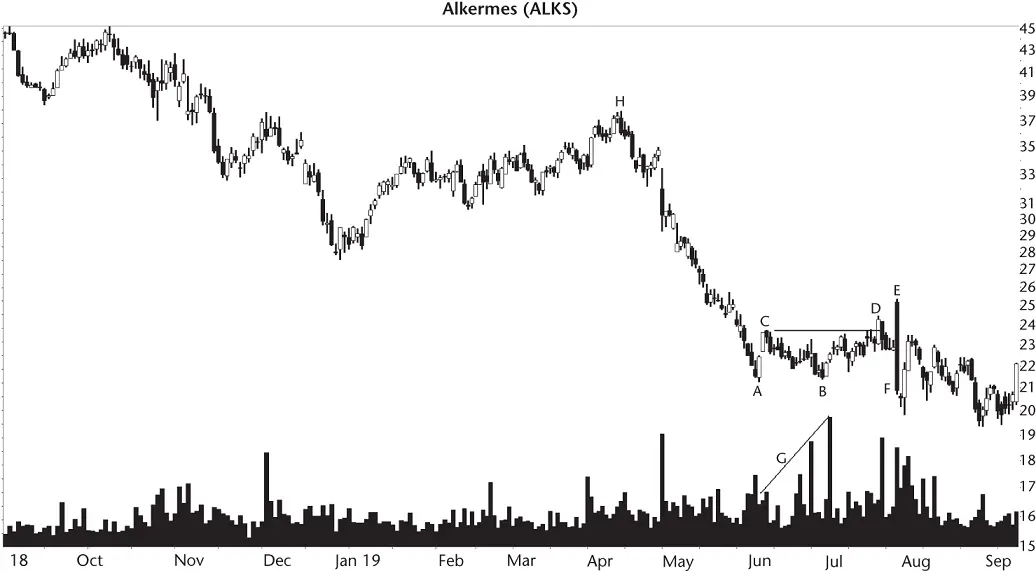Price trend.The downtrend from A to B is a steep drop like that shown in the figure. You want to avoid patterns that see price meander or even move sideways as the drop approaches B. If price takes its time reaching the first bottom, then the chart pattern is probably a double bottom (see one of the Adam & Eve varieties).
Eyeball the height from the center peak between the two bottoms to the lower of the two bottoms. Then make sure the left side of the pattern is at least that height above the central peak.
For example, the height of the big W is the high price at point C minus the low at B. The left side must be at least this height above C. In this case, the downtrend begins at A, which is well above C, so the downtrend from A to B is tall enough. A tall left side is what separates big Ws from double bottoms. A big W is a type of double bottom, but few double bottoms are big Ws. I hope that makes cents (sense).
Volume.Don't disqualify a big W because of its volume trend. However, most of the time, you'll see volume trending lower from valley B to D. Linear regression on the big W shown in the figure says volume slopes upward. It doesn't look like it does, but the numbers say otherwise. I show the upward trend at H.
Breakout direction, confirmation.Price always breaks out upward from a big W. If it doesn't, then you don't have a big W. A breakout occurs when price closes above the hill between the two bottoms. In Figure 7.2, that would be a close above C, which I show as a horizontal line at E.
Price confirms the big W as a valid chart pattern when it closes above C. Again, if you don't have confirmation, then you don't have a big W.
Duration.I did not set a minimum or maximum width between the two valleys. They ranged from a very narrow 4 days to 260 days. I looked at the 4‐day pattern, and it looks fine.
Figure 7.3shows what the failure of a big W to perform looks like. The big W is at ACB, with A and B being the bottoms and C being the hill between the bottoms. Price drops from H in a long and steep move to the first bottom. The stock confirms the pattern as valid at D, where it closes above the horizontal line drawn from the high at C.
Price spikes higher at E, but closes the trading day near the bottom of the price bar, at F. That close is below the lower of the two bottoms (A). The breakout from this big W was upward (at D), but price reversed and closed below the bottom of the big W, busting the upward breakout.

Figure 7.3 Price busts the upward breakout from this big W.
Volume (G) in this example slopes upward from A to B. Table 7.6says that volume slopes downward 69% of the time on average, and yet all three figures shown so far have upward volume.
Why did this big W fail to rise back to the launch price (H), the point where the long downtrend leading to point A began?
We can only speculate as to the answer. I checked the Internet for news at price bar EF and found that the company released second‐quarter earnings before the market opened. Apparently the stockholders couldn't make up their minds about the news. Sometime during the day, price climbed up to E (perhaps on news that the company settled a patent dispute). Once price dropped below bottom B, it may have triggered stops, helping price decline to F. In this case, it appears the earnings announcement prevented the big W from fulfilling its promise of rising to H.
Table 7.2shows general statistics for the big W pattern.
Number found.Most of the patterns I found manually over the years but automated finding them to highlight big Ws I might have missed (like the one shown in Figure 7.3). I checked each one to be sure it was a proper pattern. I uncovered almost 2,700 patterns in 765 stocks using data from July 1991 to September 2019. Not all stocks covered the entire period, and some no longer trade.
Table 7.2 General Statistics
| Description |
Bull Market |
Bear Market |
| Number found |
2,172 |
514 |
| Reversal (R), continuation (C) occurrence |
100% R, 0% C |
100% R, 0% C |
| Average rise |
46% |
30% |
| Standard & Poor's 500 change |
13% |
1% |
| Days to ultimate high |
213 |
83 |
| How many change trend? |
62% |
47% |
Reversal (R), continuation (C) occurrence.The big W is a reversal pattern. Price enters the pattern from the top (going down) and exits out the top (going up), reversing the inbound downtrend by definition.
Average rise.The average rise is decent in bull markets, with gains averaging 46%. That's if you trade it perfectly, over 2,000 times. Your trades may do better or worse than what's shown in the table. As you would expect, bear markets with upward breakouts see price climb less far than in bull markets.
Standard & Poor's 500 change.I measured performance of the S&P 500 index from the date of the big Ws breakout to the ultimate high. The table shows the result, which is inferior to the big W's performance. I'm not sure if the comparison is fair. It might be like comparing the times of two marathon runners, one who is top ranked and the other who is an amateur. The top‐ranked runner will have a better time than one who walks the 26 miles.
Days to ultimate high.To gain 46%, it takes time, about 7 months in bull markets. Bear markets see gains taking less time (about 3 months), but that's because the average rise is less, 30%. However, a check of the numbers says the velocity in bear markets is higher than in bull markets, even when a rising price trend is heading against the current in bear markets. The bear market velocity is almost twice as fast as in bull markets. It might be because of the lack of a posted speed limit.
How many change trend?I counted how many big Ws saw price rise more than 20% after the breakout, and I must say, the bull market posts a terrific number (ranking sixth and eighth for bull and bear markets, respectively).
Big Ms in bear markets show good performance, too, but not as good as in bull markets. That's expected, of course (a rising tide lifts all boats in bull markets, but bear markets depress performance after upward breakouts).
Table 7.3shows cumulative failure rates for big Ws. The breakeven failure rate is 9%. That means 9% of the big Ws fail to see price rise more than 5% after the breakout.
Look at how the failure rates climb. In bull markets, 20% fail to see price rise more than 10%.
Table 7.3 Cumulative Failure Rates
| Maximum Price Rise (%) |
Bull Market |
Bear Market |
| 5 (breakeven) |
201 or 9% |
48 or 9% |
| 10 |
229 or 20% |
85 or 26% |
| 15 |
206 or 29% |
82 or 42% |
| 20 |
185 or 38% |
57 or 53% |
| 25 |
177 or 46% |
45 or 62% |
| 30 |
141 or 52% |
36 or 69% |
| 35 |
144 or 59% |
32 or 75% |
| 50 |
296 or 73% |
45 or 84% |
| 75 |
248 or 84% |
44 or 92% |
| Over 75 |
346 or 100% |
40 or 100% |
Table 7.4 Breakout and Post‐Breakout Statistics
| Description |
Bull Market |
Bear Market |
| Breakout direction |
100% up |
100% up |
| Performance of breakouts occurring near the 12‐month low (L), middle (M), or high (H) |
L48%, M46%, H42% |
L31%, M29%, H28% |
|
| Throwbacks occurrence |
64% |
66% |
| Average time to throwback peaks |
8% in 6 days |
11% in 6 days |
| Average time to throwback ends |
12 days |
12 days |
| Average rise for patterns with throwbacks |
45% |
27% |
| Average rise for patterns without throwbacks |
48% |
34% |
| Percentage price resumes trend |
76% |
60% |
|
| Performance with breakout day gap |
47% |
39% |
| Performance without breakout day gap |
46% |
28% |
| Average gap size |
$0.38 |
$0.47 |
Want to make 50% on your trades? You'll lose 73% of the time in bull markets (that's one winner and three losers, and that's if you trade it perfectly). In bear markets, the results are even worse with 84% failing to climb more than 50%.
Читать дальше













